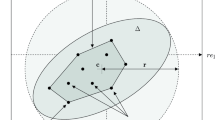Abstract
This paper considers a model of opinion dynamics in a social network with two principals, in which the members may affect the opinions of each other and their opinions evolve according to a time-homogeneous Markov chain. We study the existence of a consensus in this network for two types of influence models, namely, when the principals may or may not affect the opinions of each other directly. In addition, we find the values of social network parameters under which a consensus is reached. For the cases without a consensus in its standard definition, we introduce the notion of a consensus of the majority and find the parameter values under which it is reached. Two numerical examples illustrate the obtained theoretical results.
Similar content being viewed by others
References
DeGroot, M.H., Reaching a Consensus, J. Am. Statist. Ass., 1974, vol. 69, no. 345, pp. 118–121.
Golub, B. and Jackson, M.O., Naive Learning in Social Networks and the Wisdom of Crowds, Am. Econom. J.: Microeconomics, 2010, vol. 2, no. 1, pp. 112–149.
Buechel, B., Hellmann, T., and Klöbner, S., Opinion Dynamics and Wisdom under Conformity, J. Econom. Dynam. Control, 2015, vol. 52, pp. 240–257.
Bure, V.M., Ekimov, A.V., and Svirkin, M.V., A Simulation Model of Forming Opinion Profile within a Collective, Vestn. St.-Peterburg. Univ., Ser. 10: Prikl. Mat. Inform. Prots. Upravlen., 2014, no. 3, pp. 93–98.
Gubanov, D.A., Novikov, D.A., and Chkhartishvili, A.G., Informational Influence and Informational Control Models in Social Networks, Autom. Remote Control, 2011, vol. 72, no. 7, pp. 1557–1567.
Gubanov, D.A., Novikov, D.A., and Chkhartishvili, A.G., Sotsial’nye seti: modeli informatsionnogo vliyaniya, upravleniya i protivoborstva (Social Networks: Models of Informational Influence, Control and Confrontation), Moscow: Fizmatlit, 2010.
Grabisch, M. and Rusinowska, A., A Model of Influence Based on Aggregation Functions, Math. Social Sci., 2013, vol. 66, pp. 316–330.
Parilina, E. and Sedakov, A., Stable Cooperation in Graph-Restricted Games, Contrib. Game Theory Manage., 2014, vol. 7, pp. 271–281.
Chebotarev, P.Yu. and Agaev, R.P., On the Asymptotics of Consensus Protocols, Upravlen. Bol’sh. Sist., 2013, vol. 43, pp. 55–77.
Doob, J.L., Stochastic Processes, New York: Wiley, 1990.
Sevast’yanov, B.A., Kurs teorii veroyatnostei i matematicheskoi statistiki (A Course on Probability Theory and Mathematical Statistics), Moscow: Nauka,1982.
Author information
Authors and Affiliations
Corresponding author
Additional information
Original Russian Text © V.M. Bure, E.M. Parilina, A.A. Sedakov, 2016, published in Problemy Upravleniya, 2016, No. 1, pp. 21–28.
Rights and permissions
About this article
Cite this article
Bure, V.M., Parilina, E.M. & Sedakov, A.A. Consensus in a social network with two principals. Autom Remote Control 78, 1489–1499 (2017). https://doi.org/10.1134/S0005117917080094
Received:
Published:
Issue Date:
DOI: https://doi.org/10.1134/S0005117917080094




